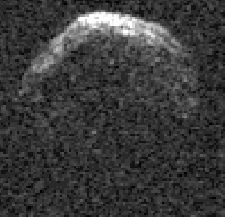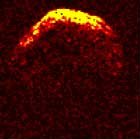(29075) 1950 DA: Difference between revisions
Michaelbusch (talk | contribs) Adjusting wording. |
Michaelbusch (talk | contribs) Adjusting wording. The case of 1950 DA in particular had no particular influence on interest in space colonization, although the impact hazard as a whole has. |
||
| Line 56: | Line 56: | ||
Knowledge of 1950 DA's trajectory has improved with time. In 2002, it had the highest [[Palermo Technical Impact Hazard Scale|Palermo rating]] with a value of 0.17 for a possible collision in 2880.<ref name="NEO-1950DA"/> Modeling suggests 1950 DA is a retrograde rotator.<ref name=Farnocchia2013/> In mid-2013, the odds of an Earth impact in 2880 were estimated as 1 in 2,270 (0.044%) with a Palermo rating of −0.58<ref name="risk-table"/><ref name=Farnocchia2013/>. A new analysis of DA's trajectory in October 2013, including additional radar astrometry from [[Arecibo Observatory|Arecibo]] in 2012 and an updated set of predictions of Earth's orbit and those of the other planets ([[Jet Propulsion Laboratory Development Ephemeris|DE431]]) ruled out the 2880 impact entirely. |
Knowledge of 1950 DA's trajectory has improved with time. In 2002, it had the highest [[Palermo Technical Impact Hazard Scale|Palermo rating]] with a value of 0.17 for a possible collision in 2880.<ref name="NEO-1950DA"/> Modeling suggests 1950 DA is a retrograde rotator.<ref name=Farnocchia2013/> In mid-2013, the odds of an Earth impact in 2880 were estimated as 1 in 2,270 (0.044%) with a Palermo rating of −0.58<ref name="risk-table"/><ref name=Farnocchia2013/>. A new analysis of DA's trajectory in October 2013, including additional radar astrometry from [[Arecibo Observatory|Arecibo]] in 2012 and an updated set of predictions of Earth's orbit and those of the other planets ([[Jet Propulsion Laboratory Development Ephemeris|DE431]]) ruled out the 2880 impact entirely. |
||
The energy released by a collision with an object the size of 1950 DA would cause major effects on the [[climate]] and [[biosphere]], which would be devastating to [[human]] [[civilization]]. The discovery of the potential impact |
The energy released by a collision with an object the size of 1950 DA would cause major effects on the [[climate]] and [[biosphere]], which would be devastating to [[human]] [[civilization]]. The discovery of the potential impact heightened interest in [[asteroid deflection strategies]]. |
||
==See also== |
==See also== |
||
Revision as of 02:28, 7 February 2014
 Arecibo radio telescope radar image of 1950 DA taken on March 3, 2001, from a distance of 0.052 AU (22 lunar distances) | |
| Discovery | |
|---|---|
| Discovered by | Carl A. Wirtanen |
| Discovery date | February 22, 1950[1] |
| Designations | |
| 2000 YK66[2] | |
| Apollo | |
| Orbital characteristics[1] | |
| Epoch 2011-Aug-27 (JD 2455800.5) (Uncertainty=0)[1] | |
| Aphelion | 2.5618 AU (383.23 Gm) |
| Perihelion | 0.83529 AU (124.95 Gm) |
| 1.6985 AU (254.09 Gm) | |
| Eccentricity | 0.50823 |
| 808.59 d (2.21 yr) | |
Average orbital speed | 21.30 km/s |
| 246.03° | |
| Inclination | 12.175° |
| 356.74° | |
| 224.59° | |
| Physical characteristics | |
| Dimensions | 1.1–1.4 km 1.1 km (mean)[3] |
| Mass | >2×1012 kg[4] |
Mean density | >3.0 g/cm³ |
| 0.0884 d (2.1216 h)[1] | |
| Albedo | 0.2–0.25 |
Spectral type | E or M |
| 17.0[1] | |
(29075) 1950 DA is a near-Earth asteroid. It is notable for having the highest known probability of impacting Earth.[5] In 2002, it had the highest Palermo rating with a value of 0.17 for a possible collision in 2880.[3] This potential impact was ruled out in late 2013, as more information on the asteroid's trajectory and physical properties became available.
Discovery and name
1950 DA was first discovered on February 23, 1950, by Carl A. Wirtanen at Lick Observatory.[1] It was observed for seventeen days[6] and then lost because the short observation arc resulted in large uncertainties in Wirtanen's orbital solution. On December 31, 2000, it was recovered as 2000 YK66 and 2 hours later was recognized as 1950 DA.[6]
Observations

On March 5, 2001, 1950 DA made a close approach to Earth of 0.0520726 AU (7,789,950 km; 4,840,450 mi).[7] It was studied by radar at the Goldstone and Arecibo observatories from March 3 to 7, 2001.[6]
The studies showed that the asteroid has a mean diameter of 1.1–1.4 km. Optical lightcurve analysis by Lenka Sarounova and Petr Pravec shows that its rotation period is 2.1216 ± 0.0001 hours. Due to its short rotation period and high radar albedo, 1950 DA is thought to be fairly dense (more than 3 g/cm³) and likely composed of nickel–iron.[8]
Possible Earth impact
That 1950 DA has one of the best-determined asteroid orbital solutions is due to a combination of:[6]
- an orbit moderately inclined (12 degrees)[1] to the ecliptic plane (reducing in-plane perturbations)
- high-precision radar astrometry, which provides its distance and is complementary to visual-wavelength measurements of angular positions
- a 64-year observation arc[1]
- an uncertainty region controlled by resonance
Main-belt asteroid 78 Diana (~125 km in diameter) will pass about 0.003 AU (450,000 km; 280,000 mi) from 1950 DA on August 5, 2150.[6] At that distance and size, Diana will perturb 1950 DA enough so that the change in trajectory is notable by 2880 (730 years later).
If 1950 DA continues on its present orbit, it will approach Earth on March 16, 2880.[3] However, over the intervening time, its rotation will cause its orbit to slightly change as a result of the Yarkovsky effect. Available radar and optical data suggest two possible pole directions and corresponding trajectories[3]. Both trajectories pass many millions of kilometers from Earth, so 1950 DA does not have a significant chance of impacting Earth.
Knowledge of 1950 DA's trajectory has improved with time. In 2002, it had the highest Palermo rating with a value of 0.17 for a possible collision in 2880.[3] Modeling suggests 1950 DA is a retrograde rotator.[9] In mid-2013, the odds of an Earth impact in 2880 were estimated as 1 in 2,270 (0.044%) with a Palermo rating of −0.58[5][9]. A new analysis of DA's trajectory in October 2013, including additional radar astrometry from Arecibo in 2012 and an updated set of predictions of Earth's orbit and those of the other planets (DE431) ruled out the 2880 impact entirely.
The energy released by a collision with an object the size of 1950 DA would cause major effects on the climate and biosphere, which would be devastating to human civilization. The discovery of the potential impact heightened interest in asteroid deflection strategies.
See also
References
- ^ a b c d e f g h "JPL Small-Body Database Browser: 29075 (1950 DA)". Jet Propulsion Laboratory. 2010-10-04 last obs (arc=60.61 years). Retrieved 2011-11-19.
{{cite web}}: Check date values in:|date=(help) - ^ "MPEC 2001-A26 : 1950 DA = 2000 YK66". IAU Minor Planet Center. January 4, 2001. Retrieved November 19, 2011. (K00Y66K)
- ^ a b c d e "Asteroid 1950 DA". NASA/JPL Near-Earth Object Program Office. Archived from the original on July 21, 2011. Retrieved October 14, 2011.
- ^ use a spherical radius of 0.55 km (0.34 mi); volume of a sphere * density of 3 g/cm3 yields a mass (m=d*v) of 2.09×1012 kg
- ^ a b "Sentry Risk Table". NASA/JPL Near-Earth Object Program Office. October 10, 2013. Retrieved October 11, 2013.
- ^ a b c d e Giorgini, J. D.; Ostro, S. J; Benner, L. A. M.; Chodas, P.W.; Chesley, S.R.; Hudson, R. S.; Nolan, M. C.; Klemola, A. R.; Standish, E. M.; Jurgens, R. F.; Rose, R.; Chamberlin, A. B.; Yeomans, D. K.; Margot, J.-L. (2002). "Asteroid 1950 DA's Encounter With Earth in 2880: Physical Limits of Collision Probability Prediction" (PDF). Science. 296 (5565): 132–136. Bibcode:2002Sci...296..132G. doi:10.1126/science.1068191. PMID 11935024.
{{cite journal}}: CS1 maint: multiple names: authors list (link) - ^ "JPL Close-Approach Data: 29075 (1950 DA)". 2010-10-04 last obs (arc=60.61 years). Retrieved 2011-11-19.
{{cite web}}: Check date values in:|date=(help) - ^ 1950DA Planning on the NASA Web site (last accessed on October 7, 2007). (Broken)
- ^ a b Farnocchia, Davide; Chesley, Steven R. (2013). "Assessment of the 2880 impact threat from asteroid (29075) 1950 DA". arXiv:1310.0861.
{{cite journal}}: Cite journal requires|journal=(help)
External links
- Orbital simulation from JPL (Java) / Ephemeris
